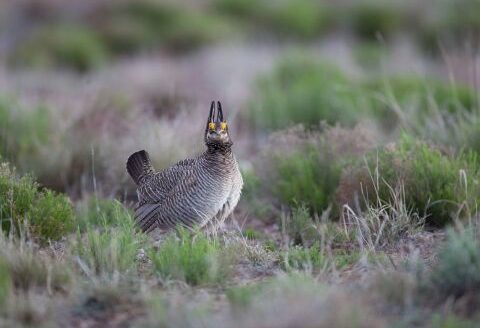Gambling with species extinction

It’s a gambler’s life to turn a losing proposition into a false sense of victory. Send one to the blackjack table with $1,000; they lose $900, win back $100, and declare they’ve won.
Such it is with lesser prairie-chicken, the enduring, iconic wild grouse of the southern Great Plains prairies. Their populations have been reduced by 90% from as recently as the 1960s, and with a recent positive bump of maybe 5% after a couple years with improved rainfall we have some saying: “We’re good!” We are not good, as the recent proposal by the U.S. Fish and Wildlife Service to list the chicken under the Endangered Species Act indicates.
Go back further in time when Native American Tribal dances were inspired by the spectacular spring mating dance of the chickens, and there were likely millions of birds. From that rich and patient perspective, there are only a tiny fraction remaining in scattered remnants today.
Others remain inspired by chickens. Bird enthusiasts travel from around the world to watch the crazy, foot-stomping, feather-puffing mating rituals and fights of male chickens in April. But for how much longer?
Having lost 90% of our prairie heritage, are we greedy or careless enough to keep going until the last 10% is gone? Or do we take this moment, when we’re considering admitting the chicken to the wildlife emergency room full of other endangered species, to say, “no more”?
Prairie ecosystems are the most threatened and least conserved in North America. Chickens survive today only because of generous private landowners who steward almost all of the remaining habitat. If Americans are to save the last fragments of prairies and chickens, those landowners deserve our support.
And we know how to support them through farm bill programs, well-designed mitigation programs, and other voluntary efforts. In fact, the majority of chickens remaining occur among lands voluntarily enrolled in the U.S. Department of Agriculture’s Conservation Reserve Program, providing more intact and contiguous native prairie habitat.
Chickens are so tied to broad, unspoiled prairie landscapes that if we lose them, then we’ll know we’ve lost our last wild prairies. With this loss, we would lose other grassland birds species which, as a group, have declined here more than in any other North American ecosystem. We would lose important pollinators, native grasses and flowers, good soil health, water quality and quantity, and even the opportunity to sequester carbon to help fight climate change.
Too much is at stake to gamble away the last, best places for chickens and people who love prairies. The time to act is now. We know how to act. We have the tools available. All that is required is the collective will to support those who would want to conserve grouse as they have for generations.
Ted Koch is the executive director of the North American Grouse Partnership.



